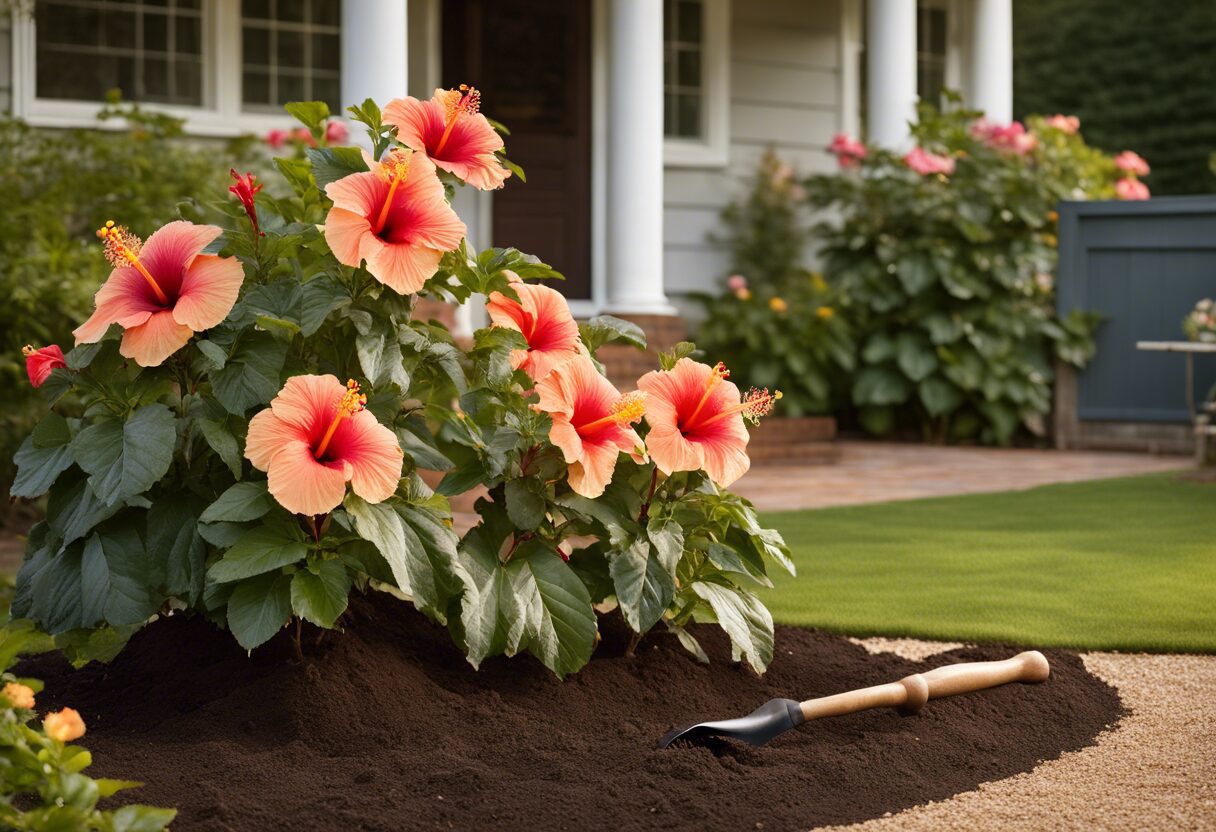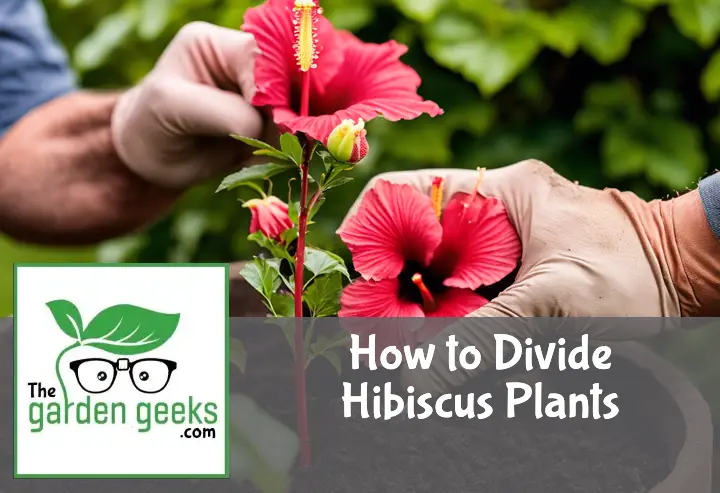Ever found yourself staring at your lush, blooming Hibiscus Plants in the garden and wondered how to keep them thriving? Well, one magic trick is to divide them. Yeah, you heard it right! Divide to multiply, a paradox that works wonders in the plant world.
Now, you might be thinking, “Divide Hibiscus Plants? Sounds like a surgical procedure!” Don’t worry, it’s not as complicated as it seems. Keep reading about ‘How to Divide Hibiscus Plants?’ and I promise you’ll be dividing those beauties like a pro in no time!
Key Takeaways
- The best time to divide hibiscus plants is in early spring.
- Start by watering the plant thoroughly a day before division.
- Carefully dig around the plant, lift it out and gently separate the clumps.
- Each new section should have roots and at least one shoot.
- Replant each division immediately in well-draining soil, water thoroughly and provide adequate sunlight.
- Regularly monitor for pests or diseases during the first few weeks after division.
Understanding Hibiscus Plants
Let’s get to know our star of the day, the hibiscus plant. This beauty is more than just a pretty face. It’s got some serious importance in both gardens and cultures worldwide. But here’s the kicker, to keep these plants healthy and thriving, you gotta divide hibiscus plants every now and then.
What are Hibiscus Plants?
Hibiscus plants, oh boy, where do I start? These lovelies hail from warm-temperate, subtropical and tropical regions. So basically, they’re sun-lovers! They come in different shapes and sizes but are mostly known for their large, trumpet-shaped flowers.
Now about their looks – they’re like the supermodels of the plant world. With glossy leaves and blooms that can be as big as your hand! And let’s not forget about the colors – reds, pinks, yellows…you name it!
There are over 200 species of hibiscus out there. Some common ones include Hibiscus rosa-sinensis (Chinese hibiscus) and Hibiscus syriacus (Rose of Sharon). Each one has its own unique charm.
Why is Dividing Hibiscus Plants Necessary?
Now onto the nitty-gritty: why should we divide hibiscus plants? Well folks, it’s all about promoting growth and maintaining health. By dividing them, you’re giving each section a chance to develop its own roots system. It’s like moving out of your parents’ house – you finally get your own space!
But what happens if you don’t divide them? Well, it ain’t pretty. The plants can become overcrowded which leads to poor growth and makes them more susceptible to diseases. So remember folks – divide to thrive!
Best Time to Divide Hibiscus Plants

When it comes to dividing hibiscus plants, timing is everything. It’s not just about grabbing a shovel and going for it. You need to consider the hibiscus plant division time and understand the seasonal plant care requirements.
Identifying the Right Season
The right season plays a crucial role in successful hibiscus division. So, when is the best time to divide hibiscus? Well, you might want to circle spring on your calendar.
Spring is considered the best season for dividing hibiscus because it gives them plenty of time to establish before winter. Plus, this is when they’re actively growing, making it easier for them to recover from the shock of division.
But remember, every garden and climate can be different. So, always keep an eye on your plant’s growth and adjust accordingly.
Signs Your Hibiscus Plant is Ready for Division
Now that we’ve nailed down the timing let’s talk about signs that indicate your hibiscus plant is ready for division. It’s not like they come with a “Divide Me Now!” sign (if only gardening were that easy!).
Instead, look out for signs like robust growth or overcrowding in the pot or garden bed. If your hibiscus has been in the same spot for several years and seems less vigorous than before, it might be screaming out for a little space!
Also, if you notice fewer flowers or smaller leaves than usual, these could be signs that your hibiscus is ready for division too.
So there you have it! With these tips in mind, you’ll be dividing those beauties like a pro in no time!
Preparing for Division of Hibiscus Plants
Before you dive into the process of Divide Hibiscus Plants, it’s crucial to prepare adequately. This includes gathering the right tools and prepping your hibiscus for a successful division. Remember, proper preparation is key to ensuring your hibiscus thrives post-division.
Gathering Necessary Tools and Materials
For a successful hibiscus plant division, you’ll need some specific garden tools. A sharp, clean knife or pruners are essential for making clean cuts. You’ll also need a sturdy shovel or spade for digging around and lifting the plant. Don’t forget about potting soil and containers if you plan on replanting immediately! Having all these necessary materials for plant division ready will make the whole process smoother.
Preparing the Plant for Division
Now, let’s talk about how to prep your hibiscus for division. First off, ensure your plant is healthy – sickly plants might not survive the stress of division. Water your hibiscus thoroughly a day before dividing; this keeps it hydrated during the process. Also, trim any dead or diseased branches to keep them from draining energy from new growths post-division. These steps to prepare plants for division are vital in ensuring hibiscus health pre-division.
How to Properly Divide a Hibiscus Plant?
Dividing your hibiscus plants is not only a great way to propagate new plants, but it also promotes healthy growth. It’s all about hibiscus plant care and ensuring that your garden stays vibrant and colorful.
Locating the Division Point
When it comes to dividing hibiscus plants, the first step is identifying the right spot for division. You’re looking for a mature hibiscus plant with a robust root system.
The division point should ideally be where you see healthy roots branching out. This is crucial because these roots will support the new plant once it’s divided.
Remember, timing is everything in hibiscus propagation. The optimal time for dividing is during late winter or early spring when the plant is dormant.
Executing the Division Process
Now that you’ve located your division point, it’s time to get down to business – hibiscus plant division! Make sure you have clean, sharp tools for this process to avoid causing unnecessary damage.
Start by gently digging around the base of your hibiscus, taking care not to harm those precious roots. Once you’ve exposed enough of the root system, carefully cut through at your chosen division point.
After successfully dividing your hibiscus, don’t forget about aftercare! Newly divided plants need extra TLC so keep them well-watered and in a sheltered location until they establish themselves.
And there you have it folks! A simple guide on how to divide hibiscus plants and ensure their successful propagation. Happy gardening!
Post-Division Care for Hibiscus Plants
After you Divide Hibiscus Plants, it’s crucial to give them some TLC. We’re talking about proper hibiscus plant care and post-division maintenance. This includes replanting, watering, fertilizing, and keeping an eye on their growth and health.
Replanting Divided Sections
So you’ve got your divided sections of hibiscus ready to go. Now what? Well, successful hibiscus replanting starts with choosing the right spot. You want a place that gets plenty of sunlight but also has some shade during the hottest part of the day.
Next up is preparing the soil. It should be well-draining and rich in organic matter. If your garden soil isn’t up to snuff, don’t fret! You can always improve it by adding compost or other organic amendments.
Finally, dig a hole that’s deep enough for the root ball of your divided hibiscus section. Place it in the hole, backfill with soil, and give it a good watering to settle everything in place.
Watering and Fertilizing Needs
Now let’s talk about watering and fertilizing needs for these newly divided hibiscus plants. When it comes to watering divided hibiscus, consistency is key. They like their soil to be consistently moist but not waterlogged.
Fertilizer-wise, these newbies will appreciate a balanced fertilizer applied every couple of weeks during the growing season. Just remember not to overdo it – too much fertilizer can do more harm than good!
Monitoring Growth and Health
Last but certainly not least is monitoring the growth and health of your newly divided hibiscuses. Keep an eye out for signs of stress like wilting leaves or slow growth – these could indicate that something’s amiss with your plant’s new digs.
Regularly checking the health of new plants is also important. Look out for pests or disease, and take action at the first sign of trouble. And don’t forget to celebrate your successes – seeing those first new blooms on your divided hibiscus is a sure sign that you’re doing something right!
Common Mistakes to Avoid When Dividing Hibiscus Plants
When it comes to dividing hibiscus plants, even the greenest thumbs can make a few blunders. These errors often boil down to incorrect timing, inadequate preparation, and poor post-division care. Let’s delve into these hibiscus plant division errors and see how we can avoid them.
Incorrect Timing
Timing is everything in gardening, especially when you’re dividing your hibiscus. The wrong time can lead to a whole host of problems. You see, incorrect timing for dividing hibiscus can stress the plant out, affecting its growth and blooming potential.
So what constitutes incorrect timing? Well, if you’re trying to divide your hibiscus in the peak of summer or dead of winter, you’re asking for trouble. The importance of timing in plant division cannot be overstated!
Inadequate Preparation
Next up on our list of dividing hibiscus mistakes is inadequate preparation. This isn’t just about forgetting your gloves or misplacing your trowel – though that’s annoying too! No, we’re talking about not properly preparing the plant and its new home.
A lack of proper prep work can lead to shock during the division process. This shock could result in wilting leaves or even death (of the plant, not you). Remember folks, preparing for hibiscus division is key!
Poor Post-Division Care
Finally, let’s chat about aftercare – or rather the lack thereof. Proper post-division care is crucial for helping your newly divided hibiscus thrive. Unfortunately, this is where many gardeners drop the ball.
Neglecting watering schedules or failing to provide enough sunlight are common mistakes during this period. The importance of aftercare in plant division should never be underestimated. So, don’t let your hard work go to waste with poor post-division care for hibiscus!
To Wrap Up
And there you have it, folks! You’re now a pro at how to Divide Hibiscus Plants. It’s like slicing a pie – but instead of getting dessert, you get more beautiful blooms!
So go ahead, don’t be shy. Give your hibiscus some love and multiply the joy they bring to your garden.


